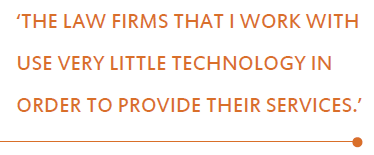Summary
GC speaks to Castro and Morales to uncover the technology transformation taking place within the legal team of pharmaceutical giant Bayer.
GC: Can you tell me about how you use technology in the Bayer legal team in Costa Rica?
Alejandra Castro (AC): The legal headquarters in Germany have organised a worldwide structure in the legal department. We might be a unique global legal department where all our strategies are aligned including the vision on technology that should lead our functions. We centralise in a single IT tool the contracts, compliance cases, and data privacy processes, in addition to the monitoring of regulations in the region, plus patents as well.
As legal departments in Bayer, we handle various databases, and we are currently migrating to a new IT tool handled by regional expert teams, to make sure that everyone uses the same templates for contracts, with the same quality of service and the same regulations. The tool allows being a self-service contract database for contracts that we have already drafted, which will be harmonised for all the legal entities that we have. There will be an ability to make an online request for different templates outside those already drafted, and then these requests for new contracts will done by the legal department. Our expectation - and we are already reviewing this and finding this is what is happening now - is that the workload is getting lowered. We are trying to use these tools in order to make the process more agile, and to speed up all of the negotiations that we have with external vendors and so on.
Catalina Morales (CM): This new tool grants a contract life cycle management system. This means that you can find a template, you can send it to your business partner in legal, you can send it to your provider from the platform, the provider can give any feedback in the platform as well and, if they have the digital signature, they can also sign it online, and then you just store it in the same system. The idea is to use this system for contracts from the beginning.
AC: On the IP side, we have a different tool - it's the same IT platform, but it's a different tool where we upload all the patents that we have. It helps us by reminding us, for example, about deadlines and other IP risks that are very important with patents. If you miss a deadline, you can lose your patent, so for us it's very important to keep a record of the timeline. In the past, patents were handled through local law firms and they were the ones that kept the reminders on the deadlines and the stages of the patent process. Now that we have developed our own patent tools, we do all the surveillance and the follow-up of what the law firms are doing, so it has increased our work in a positive way.
CM: On the compliance side, the tool registers every event or every investigation that we have. All compliance officers in each country or region have to input everything - every advance that has been happening in the case or the investigation. It is a tool where we are recording, but also reporting to global headquarters. It helps to visualise the impact compliance is having and guide future decisionmaking, such as whether we need to reinforce training or do more work on specific topics in a specific area or country. It is also useful to use as a knowledge system - you can visualise and it even helps you show that, for example, the number of investigations has gone down since you've trained, since you've provided more information. You can see, actually in a tangible way, the results of your compliance work.
GC: Have there been any particular challenges that you've encountered as you've been developing these IT platforms?
AC: Yes, there have. The first challenge was to make sure that we have a single template and that we keep the template with the most protection for the company, no matter in which jurisdiction the contract would be enforced. In my region, there are 33 countries in which we have legal operations, all of whom have different regulations, so that was challenging.
The second challenge was that, in the past, each region had developed their own IT tool for contracts. Now that we are migrating to the new tool - which is the single tool that will be used by everyone - it creates an additional challenge for areas or regions that need to leave the tools that were already developed, and migrate to this too.
CM: There's always going to be challenges with what is a culture change. You need to explain that you're not going to do this anymore, the way you've been doing it for the last 10 years - now you have to do it this way. Obviously, that is going to take time to adjust. There's always going to be that initial scepticism about the new system - is it really going to work, do we have to do all this change if it won't work in two or three years? We do have to do a lot of convincing, a lot of explaining why actually the system works and how it is going to benefit you. That's the key: I think once they see the benefits, they get on board.
GC: Legal is one area where Bayer is implementing artificial intelligence. How are you currently using it and how do you think that use that will evolve from the sorts of things people are currently using it for?
AC: We currently have experience using AI in labour calculations, for example, for severance payments. It has already brought a lot of value to the department and it is just the beginning. I believe that, in contracts for example, we are going to see a lot more development around how artificial intelligence can help us work on our daily tasks.
CM: I think that AI could have an impact on the profession and the positions required in a legal department. A physical lawyer will always be needed, but the amount of lawyers needed in one department may decrease. For the company, or for the law firm, you could say that's better because you need fewer people to do the same amount of work, but on the human side, as a lawyer, I wouldn't like to lose my job and be replaced by technology! We need to find a common ground for us to work together.
I believe we will continue to see a rise in automation, too. It's inevitable. I don't know if it will change drastically and I don't how fast it will change, but it will definitely change. The important thing is to have a company that supports this innovation and digitalisation, because it's going to affect not only legal but every single department in the company. The engagement of the employees is going to be 100% necessary.
GC: How do you think the legal sector compares to other professional service sectors in Latin America when it comes to technology, innovation and working digitally?
AC: I think that lawyers believe they are not comparable. This is why we have sometimes not implemented technology. But I do think that our services are totally comparable to other areas that have already implemented these tools, like in accounting and finance teams. We are able and we can implement those tools - and there is no need to be afraid of that. I remember when we implemented digital signatures for several legal procedures, there was a lot of resistance from lawyers in the region, but now we use it on a regular basis and digital signatures are part of what we implement in contracts and data procedures. I think there are a lot of things that we can do and I think that legal departments are more than prepared to undertake this.
GC: How would you like to see law firms using and adapting to technology?
AC: If I request external counsel advice for legal opinions, I would love to have law firms keep a record of what they have answered to us for corporate housekeeping, to make sure that they have IT tools to give reminders on processes that are done on a yearly basis, like renewal of the corporation or payment of taxes. But it's hard to find that in the market. At least, in my country group, we don't have it. I know that I have peers in other country groups where they do have that service, but not in Central America.
We are undertaking evaluations on outside law firms focused on the technology that they are implementing, so that we can look to use that as well. But, at least in the region where we have our legal department, I don't think that there is too much going on yet. The law firms that I work with use very little technology in order to provide their services. However, from a global perspective, I know that headquarters have analysed global law firms that are using technology, so we have been able to review those technologies to see if we can apply them in our region or to our IT platforms.

GC: How can in-house teams best prepare and equip themselves for technological changes and disruption in future?
AC: There is a lot of work that has to be done from an investment and budget perspective. I think that is the first challenge that we need to face. The second is training; we're used to having legal training, but now I think it's very important to have specific training on the new IT tools that we are implementing, in order to be part of this new era where technology will be leading the legal department.
CM: As a legal department or a law firm that is not yet very technologically advanced, I would definitely recommend doing due diligence. Start small - start mapping out what systems can make your life easier. Maybe just a repository for a list of contracts, so you can upload a template, so that the whole law firm has a basic template that can be shared within a general system - that way, anyone that needs that type of contract can use it and the organisation has one face towards the client. Because, as a client, maybe one lawyer did the same type of contract differently than another lawyer, then you're giving me two different versions, and maybe in one we went to labour litigation and with the other one we didn't. So, at the end, it's easier because they would have the same standard within.
I'm talking just basic contracts, but it works with other things, like legal opinions. If you're going to give your client a legal opinion, you need to keep a record of what you said to the company and you can also start showing the benefits of having that to the managerial department, to see the importance of having that IT technology within the company.




